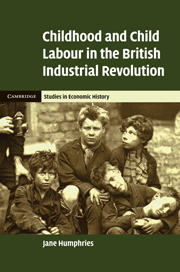2 - Sources, models, context
Published online by Cambridge University Press: 06 December 2010
Summary
Introduction
This study uses new sources and ideas borrowed from development economics to explore the role of child labour in an updated economic history of the eighteenth and nineteenth centuries. The starting point must be a defence of the unconventional sources: working-class autobiographies. Readers will likely be suspicious of such memoirs, especially as repositories of quantitative evidence, and they must be shown fit for purpose. Next, the chapter outlines several models of labour markets with child labour. Development economists use such models to identify conditions hostile to child labour and policies to hasten its demise, but they can also illuminate circumstances in which historically child labour might have increased, involved younger children and spread to hitherto exempt sectors of the economy. The third section sketches in the background: the British industrial revolution. There is no attempt to summarize the massive literature and ongoing debates. The mainstream view of the industrial revolution has undergone extensive revision in recent years. The current conventional wisdom downplays the importance of the cotton industry and of factories, factors earlier considered instrumental in promoting child labour. Nonetheless, new interpretations leave room for an extension and intensification of children's work. The argument of this book goes further. The claim is that a more gradual industrial revolution, sanitized by the relegation of dark satanic mills to a lesser role, nonetheless retained at its heart and pulsing through its life-blood this shameful feature of its older heroic variant.
- Type
- Chapter
- Information
- Publisher: Cambridge University PressPrint publication year: 2010
- 1
- Cited by

